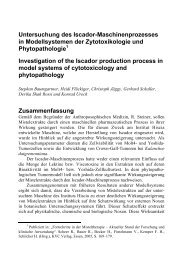Documentation of published clinical trials and ... - Institut Hiscia
Documentation of published clinical trials and ... - Institut Hiscia
Documentation of published clinical trials and ... - Institut Hiscia
Create successful ePaper yourself
Turn your PDF publications into a flip-book with our unique Google optimized e-Paper software.
Type RCT <strong>clinical</strong> <strong>trials</strong>, where necessary with double-blinding, are especially conclusive when<br />
regarding an unadulterated medication effect, excluding almost all other factors. They therefore<br />
tend to underestimate the effectiveness <strong>of</strong> the studied therapy; they are also quite removed<br />
from day-to-day <strong>clinical</strong> practice<br />
With anthroposophical medical therapies, especially with Iscador, the whole surroundings<br />
(doctor, clinic, accompanying therapies) as well as the doctor’s <strong>and</strong> patient’s wishes, beliefs <strong>and</strong><br />
activities are at least as important as the application <strong>of</strong> the medication itself. This makes the<br />
implementation <strong>of</strong> RCT type <strong>clinical</strong> <strong>trials</strong> with Iscador, especially with double-blinding, very<br />
difficult, if not impossible. For these cases multi-arm at best prospective observational studies,<br />
with provision for patient <strong>and</strong> doctor preferences, are usually preferred. Alongside the<br />
uncertainty regarding the comparability <strong>of</strong> the different therapy groups (study arms), which<br />
cannot be eliminated, it could be presumed that such studies tend to overestimate the<br />
effectiveness; however, they more convincingly reflect <strong>clinical</strong> practice.<br />
It can be concluded that both study types (RCT with double-blinding <strong>and</strong> observational studies),<br />
assuming the best case, complement each other <strong>and</strong> should consequently be included in the<br />
overall evaluation to an equal degree<br />
An approved method in order to achieve the comparability <strong>of</strong> two groups in prospective<br />
observational studies is the forming <strong>of</strong> matched pairs, as used in the epidemiological studies by<br />
Grossarth-Maticek et al. (2001). The difficulty <strong>of</strong> observing patients over longer periods <strong>of</strong> time,<br />
as necessary for survival in oncological patients, was overcome in this study. The reliability <strong>of</strong> the<br />
results was not only due to the accurate matching <strong>of</strong> the patients at the outset <strong>of</strong> the<br />
prospective data collection, but also due to accompanying prospective r<strong>and</strong>omised intervention<br />
studies which confirmed a prolonging <strong>of</strong> life due to Iscador.<br />
Good <strong>clinical</strong> practice (GCP)<br />
The guidelines for good <strong>clinical</strong> practice in <strong>clinical</strong> <strong>trials</strong> which were developed in the 1990s<br />
were not considered in the articles <strong>published</strong> up until 2002 on Iscador. This was probably due<br />
to ignorance <strong>of</strong> these guidelines, but to a large extent due to the tremendous complexity <strong>of</strong><br />
carrying out a study conforming to GCP guidelines. In many cases, the observing <strong>of</strong> these<br />
st<strong>and</strong>ards was dispensed with in order to be able to evaluate <strong>and</strong> publish the results at all. As a<br />
result, the <strong>published</strong> studies are unfortunately <strong>of</strong> very differing qualities. The quality <strong>of</strong> the<br />
studies in the following systematic reviews is analysed from various angles (Chapter 7).<br />
If the observation <strong>and</strong> adherence to the guidelines <strong>of</strong> GCP from the study design to the<br />
implementation <strong>of</strong> the study up to the evaluation is not explicitly mentioned in our presentation<br />
<strong>of</strong> the studies, then these guidelines were not applied to that study.<br />
Safety<br />
Data on the safety <strong>of</strong> a therapy with Iscador (Chapter 6) are available from only a few<br />
controlled studies. Please refer to the relevant literature summary for data on case reports.<br />
Systematic Reviews<br />
Qualitative systematic reviews assess the quality <strong>and</strong> validity <strong>of</strong> studies within a certain area <strong>of</strong><br />
research using previously defined criteria <strong>and</strong> according to the data <strong>published</strong> as well as the<br />
description <strong>of</strong> the study. There are, <strong>of</strong> course, very different aspects according to which quality<br />
can be accessed. These principles are in currently in the process <strong>of</strong> being st<strong>and</strong>ardised<br />
(Cochrane Collaboration, EBM). This st<strong>and</strong>ardisation is mainly orientated on conventional<br />
studies, <strong>of</strong> the RCT type, which most Iscador therapy studies cannot adhere to. Accordingly,<br />
both <strong>of</strong> the articles included, as well as the levels <strong>of</strong> quality <strong>of</strong> the systematic reviews presented<br />
in chapter 7 are very different; this is without taking the various time intervals <strong>of</strong> the studies into<br />
account.<br />
© Verein für Krebsforschung, CH-4144 Arlesheim




